Dog Behavior Problems That All Owners Should Know About
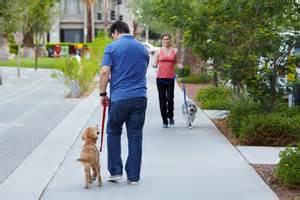
As a dog owner, you have probably experienced times when your dog has displayed some unwanted behavior problems. This is not new as some of these behaviors are common with all breeds of dogs. The most common dog behavior problems will be discussed in greater detail here.
The objective of sharing this information is to provide owners of dogs and those that are thinking of getting one to recognize some of the behaviors that most canines do as some of these behaviors are natural.
You may be wondering why your pet exhibits these behaviors too. You may be new to dog ownership, considering getting a dog or just wish to better manage your dog’s behavior problems. An understanding of the most common problems is a step in taking action in trying to solve or preventing them to happen.
By having a foundation of dog training and exercise should help to control some of these common dog behavior problems. You should be aware that exercise will not be a cure all of the behavioral problems in dogs, but a vast majority of them. The topics that will be covered here are mentioned below.
We have put together a table of contents of the topics for you because of the length of this article, just click on a topic of interest and you will be taken directly to that section. Or, you can scroll down to view them all.
Common behaviors table of contents topics:
- Aggressive Behavior
- Controlling Aggression Towards Other Dogs Video
- Step One: Determine If Their Is A Medical Problem
- Step Two: Determine What Produces The Aggression
- Step Three: Seek Professional Help
- Avoid Situations That Produce Aggressive Behavior
- Create A Training Plan
- Be Consistent, Patient, and Positive
- Other Considerations
- Barking Behavior
- Begging Behavior
- Biting Behavior
- Chasing Behavior
- Chewing Behavior
- Digging Behavior
- Inappropriate Elimination Behavior
- Jumping Behavior
- Separation Anxiety Behavior
- Conclusion
- Purchase Dog Training Behavioral Helps
Each of these behaviors will be described in greater detail below and will come with a video that will provide some additional information on how to correct that behavior.
Aggressive Behavior

If you should observe your dog exhibiting a form of aggression this is a very serious behavior problem. Any of the following may trigger your dog’s aggression:
- Growling
- Snapping
- Biting
All dog breeds are capable of aggression. This behavior can be controlled but not overnight or in just one training session. To correct this behavior, it will take some time and patience on your part.
Back to Most Common Dog Behavior Problems topics.
Controlling Aggression Towards Other Dogs Video
Short Video On Dogs Aggression – Take a look!
Back to Most Common Dog Behavior Problems topics.
Step One: Determine If Their Is A Medical Problem
Any signs of aggression may have an underlying medical problem. To be sure that this is not the case, talk with your veterinarian. He/she will examine your pet to determine if health is the issue. They may prescribe medication or treatment to help make improvements in your dog’s aggressive behavior.
Back to Most Common Dog Behavior Problems topics.
Step Two: Determine What Produces the Aggression
If no medical condition has been found, you now need to determine the cause of your dog’s aggression. Some causes of aggression are:
- Dogs growl when someone approaches them
- Dogs growl when someone approaches them when eating or chewing on a bone
- Some dogs have an aggressive reaction towards children or strangers
If you should notice this, you will need to take some corrective action by placing his food or bone in his crate. Do the same with any toys as well. If you notice your dog’s aggression towards strangers or other dogs, limit the exercise activity in your own backyard. Once you know the cause, you can come up with a training plan to correct his behavior.
If you notice your dog’s aggression do not respond by punishing him/her. You need to be positive. Punishing your dog for aggressive behavior usually backfires and will make matters worse and not better. He/she will feel the need to defend themselves by biting. For example, you notice your dog growling at children, he/she is letting you know they are uncomfortable around them. Punishing them for growling, they may not give this warning the next time they are uncomfortable, they will just bite.
Back to Most Common Dog Behavior Problems topics.
Step Three: Seek Professional Help
If health has been ruled out you may have to call in a professional dog trainer or behaviorist. They will help you to create a plan so that you can manage your dog’s aggression. Talk with your Vet who may be able to recommend one in your area. Or, you can check out the Association of Pet Dog Trainers to find one.
The professional will provide you with some plan of action to take to eliminate or reduce your dog’s aggression. Follow this plan and stick with it. Do not jump ahead. Do not move on to the next step until your dog is ready. Most of the plans will include giving your pet lots of praise and treats to change their behavior. This may take several months or more, but with patience and persistence you will see some changes in your pet’s aggressive behavior.
Back to Most Common Dog Behavior Problems topics.
Avoid Situations That Produce Aggressive Behavior
Now that you know what causes your dog’s behavior, you can avoid these situations. If your dog growls over his food and toys, feed him in his crate or take away certain toys. If he still shows aggressive behavior to strangers and other dogs, keep his exercise limited to your backyard.
Back to Most Common Dog Behavior Problems topics.
Create A Training Plan
Your trainer can help you figure out the best plan for managing your dog’s aggression. The plan will be different for each dog depending on the cause and the degree of the aggression. In most cases, you will be using positive reinforcement (i.e. lots of treats and praise) to teach your dog new behaviors. For example, if your dog is mildly aggressive towards strangers consider:
- Start by standing far away from someone your dog does not know. The distance should be far enough away so that your dog has not started to growl or snap. Then, give him lots of treats and praise.
- Gradually decrease the distance between your dog and strangers, continuing to use the positive reinforcement.
- Your dog will begin to learn that strangers equal treats, and you should see a decrease in his aggression.
You can use this same procedure process for getting your dog used to a variety of other situations or behavioral changes.
Back to Most Common Dog Behavior Problems topics.
Be Consistent, Patient, and Positive
It is important to keep things positive. Punishing your dog for aggressive behavior usually backfires, and can escalate the aggression. If you respond to a growling dog by hitting or yelling, he may feel the need to defend himself by biting. Punishment may also lead to your dog biting without warning. For example, if your dog growls at children, he is letting you know that he is uncomfortable around them. If you punish him for growling, he may not give this warning the next time he gets uncomfortable. He will simply bite which can cause some problems.
Aggression is not something that goes away overnight. It is important that once you have a plan of action in place, be consistent with it. Stick to the plan, and do not try to jump ahead to the next step. Only do that when your dog is ready. This process may take several months or more, but with patience and persistence you should see changes in your dog’s aggressive behavior. This was stated before, but it needs to be mentioned as a reminder.
Back to Most Common Dog Behavior Problems topics.
Other Considerations
In some instances, training alone will not be enough. Dogs that are aggressive because they are fearful may need medication to help manage the problem. You may have to consult with your veterinarian to discuss the options. If all else fails, your last option is whether or not your lifestyle allows you to stick with a plan. For instance, if you have a dog who growls at children and you have kids, it is impossible to avoid the situation which brings out his aggression. In this case, the best option for you and your dog may be finding him a new home.
Back to Most Common Dog Behavior Problems topics.
Barking Behavior
Do to their nature, most dogs will bark, howl and whine. However, excessive barking is a behavior that needs to be corrected and controlled. Before correcting your dog’s barking, you need to determine what is causing it. The following are the most common:
- Warning or Alert
- Playfulness or Excitement
- Attention Seeking
- Anxiety
- Boredom
- Responding to Other Dogs
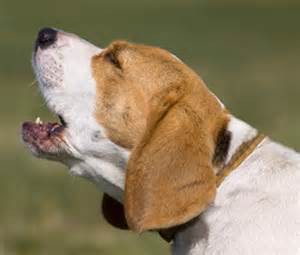
Dog owners will need to know which type of bark your dog is expressing and know the difference between them. Knowing that, you can take some corrective action. Dogs bark to warn us of danger and as a way to communicate with us. Excessive dog barking is a behavior problem and needs to be corrected and quick.
If you should suspect your dog to display some excessive barking you need to train your dog to bark and to be quiet. Do this as quickly as you can. The longer you wait, the more difficult it will be to curb this behavior.
Begin by teaching your dog “speak” and “quiet” commands. Having his favorite treat available will also come in handy. With time, your dog will learn to bark and be quiet on your command.
Back to Most Common Dog Behavior Problems topics.
Dog Barking Video
Short Video Dealing With Barking – How To Stop
Back to Most Common Dog Behavior Problems topics.
Reasons Why Dogs Bark
Dogs bark for various reasons and not just to annoy you and your neighbors. Some types of dog breeds bark more than others. You can get this information from your Vet or the pound where you got him.
Back to Most Common Dog Behavior Problems topics.
Warning or Alert Bark
It’s natural for your dog to bark when someone is at the door or when a stranger passes by. They bark because they may sense some type of threat. The sound of this bark is usually sharp, loud and authoritative. Learn to know this type of bark as it may help protect you, your home, and family.
Back to Most Common Dog Behavior Problems topics.
Anxiety Barking
This type of barking often seems to be an act of soothing for most dogs. The sound of this bark is high-pitched and often associated with whining. Dogs that exhibit this type of bark usually have separation anxiety.
Back to Most Common Dog Behavior Problems topics.
Playfulness/Excitement Bark
Generally, this bark is common in puppies and younger dogs. Most dogs will bark when playing with people or other dogs. The sound of this bark is upbeat and musical. Some dogs bark excitedly when they know they are about to go for a walk or a ride in the car or van.
Back to Most Common Dog Behavior Problems topics.
Attention-Seeking Bark
This bark is to attract attention and you will know what it means. Some dogs may whine and bark together to gain your attention. The sound is like a tone of a whining child.
Back to Most Common Dog Behavior Problems topics.
Boredom Bark
A boredom bark is a bark so they can hear their own voice. This type of bark is associated with a dog that is bored or lonely. They bark to release excess energy. This behavior can quickly be changed with exercise. Be sure your dog gets enough daily. If his boredom barks it still persists, a companion may help ease this behavior.
Back to Most Common Dog Behavior Problems topics.
Responding to Other Dogs Bark
You have probably experienced this when one dog down the street one dog barks and one by one the rest of the dogs on your block join in.
Back to Most Common Dog Behavior Problems topics.
Prevent and Stop Excessive Barking
Now that the cause of your dog’s excessive barking is known, you can begin to control their behavior. The most important thing you can do is to remove any potential sources for your dog to exhibit this behavior. Below are some tips:
- Be sure that your dog gets plenty of exercise so they will not have much energy to burn by barking.
- Avoid leaving your dog alone for a long period of time.
- Do not pet, hug, or feed your dog when they are barking for attention or out of anxiety as that would be rewarding them for this behavior.
- Do not shout at your dog to stop barking. It may cause them to bark more.
- Avoid using shock collars for punishments.
- Try to gain your dog’s attention with a clap or whistle. Once they are settled down, redirect their attention to a toy or treat. After getting his/her attention practice basic commands like “sit” or “down” to help shift their focus.
- When outside, do not let your dog bark constantly regardless of the situation.
- Train your dog with the “Speak” and “Quiet” commands.
If all of the above efforts fail, contact your veterinarian or trainer for assistance.
Back to Most Common Dog Behavior Problems topics.
Begging Behavior
Begging is a behavior that all dog owners experience usually at dinner time as they see their pet begging for a morsel of food from the table. Begging is a bad habit and many dog owners usually encourage it. What is wrong with this is that begging can lead to digestive and obesity problems in dogs. Why? Because table scraps are not treats and usually do not have sufficient nutrients your pet needs for a healthy diet.
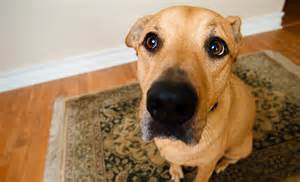
Dogs love food but table scraps will not be sufficient nutrition for them. Yes, it’s hard to resist their longing look, but don’t give in to it. Even just once creates more problems in the long run. By doing this you jeopardize your role as pack leader. Try doing this, before you sit down to eat, tell your dog to “stay”, preferably where he will not be able to stare at you.
If this doesn’t work, try confining him to another room. If he behaves, give him a special treat only after you and your family are completely finished eating. Inform all family members not to feed your dog any table food scraps, ever. Because once you start, it will be difficult to stop and may find yourself taking your pet to the vet for health issues down the road.
Another thing that you can do to help prevent his begging, is to feed him when your family sits down to eat. He will be eating his food when you are eating yours and should help reduce his begging. If he should beg, refuse to give him anything.
Back to Most Common Dog Behavior Problems topics.
Stop Dog From Begging Video
Take a look at this short begging video
Back to Most Common Dog Behavior Problems topics.
Biting Behavior
In case you may not know, dogs bite for reasons that can be traced back to instinct and pack mentality. Puppies bite and nip on other dogs and people as a means to explore their environment and learning their place in the pack. You as the dog owner must train your puppy and dog that mouthing and biting are not acceptable behaviors.
Back to Most Common Dog Behavior Problems topics.
Dog Biting Video
Short video on hot to stop dog biting – Take a look!
Back to Most Common Dog Behavior Problems topics.
Why Do Dogs Bite
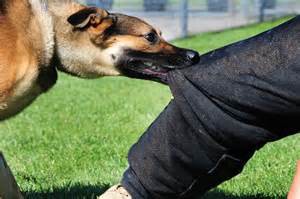
Beyond puppy behavior, the motivation to bite or snap can come from the following:
- Fear or Defensiveness
- Protection of Property
- Pain or Sickness
- Dominance Assertion
- Predatory Instinct
We now live in a society that does not accept biting and you must teach your pet not to bite especially when out in public or at home. You are responsible for training your dog to keep him under control when around other dogs, people, and other animals. Please note that any dog is capable of biting regardless of breed or size. Even the nicest dog can snap or bite when injured or afraid. All children and adults should learn how to keep themselves safe around dogs.
Back to Most Common Dog Behavior Problems topics.
Dog Owners: How To Prevent Dog Bites
- Put your dog through basic obedience training. Continue to keep up with a training program throughout your dog’s life.
- Allow your dog to meet and interact with different types of people under calm and positive circumstances, especially children, disabled persons and elderly people.
- Expose your dog to various situations on a regular basis, such as other animals, loud noises, large machines, bicycles, and anything else that might cause fear. Start at the youngest age possible, and keep the experiences positive.
- Do not discipline your dog with physical, violent, or aggressive punishments as this can be counterproductive.
- Always keep your dog on a leash or in a fenced area. Know your dog well before letting him off-leash in permitted areas. Keep your dog in your sight at all times.
- If you suspect or know that your dog has fearful or aggressive tendencies, always warn others. Do not let your dog approach people and other animals unless the situation is highly controlled. Use a muzzle only when necessary.
Back to Most Common Dog Behavior Problems topics.
Avoid Dog Bites: Tips for Kids and Adults
- Never try to approach or touch an unfamiliar dog without first asking the owner’s permission. If an owner is not present, do not go near the dog.
- When meeting an unknown dog, allow the dog to come to you. Crouch down or turn to the side. Let him sniff your hand before you pet him.
- Do not put your face close to an unknown dog – this includes “hugs and kisses.“
- Understand dog body language – most dogs will show specific warning signs before biting.
- If you are cornered by a dog, remain still and avoid eye contact. Never run and/or scream. When the dog stops paying attention to you, slowly back away.
- If knocked over by a dog, fall to your side in a fetal position, covering your head and face. Remain very still and calm.
- Never approach a dog that is eating, sleeping or caring for puppies. Dogs in these situations are more likely to be protective and can become startled.
- Never leave young children or babies alone with a dog for any reason.
- Do not approach, touch or attempt to move an injured dog. Instead, contact a veterinary professional or animal control for assistance.
Back to Most Common Dog Behavior Problems topics.
What To Do If a Dog Bite Occurs
- The dog owner should confine the dog, then immediately assist the victim.
- The victim, if able, should wash the bite area thoroughly with warm, soapy water.
- Contact a medical professional right away (depending on the severity of the bite, an ambulance may be needed). The bite victim should follow medical instructions thoroughly.
- The dog’s veterinarian as well as local authorities should be contacted.
- The dog owner should comply with officials, providing all requested medical information on the dog – especially Rabies vaccine history. This information should also be provided to the victim.
- The dog owner must take measures to prevent the dog from biting again – contact a professional trainer and possibly a veterinary behaviorist. Be aware that some local ordinances require quarantine or even euthanasia.
Back to Most Common Dog Behavior Problems topics.
Chasing Behavior
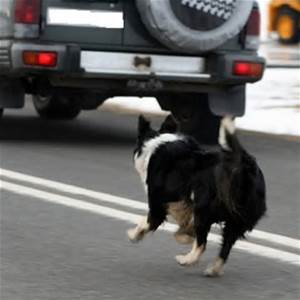
The chasing in a dog is a natural instinct and some dog breeds have a stronger instinct in this area than others. You will have to teach your pet to control it. This will take time and patience on your part as the owner. You will have to look out for the safety of your pet at all times. Many dogs will chase other animals, people, and cars which can lead to dangerous results. You won’t be able to stop your dog from chasing, but you can take some steps to prevent a disaster from happening.
Here are some suggestions:
- Keep your dog on a leash at all times (unless directly supervised indoors).
- Train your dog to “come” when called.
- Have a dog whistle or noisemaker on hand to get your dog’s attention.
- Stay aware and watch for potential triggers, like joggers.
You can prevent his chasing from getting out of control by dedicated training over the course of your dog’s life. This will teach him to focus his attention on you first before chasing an animal, person, or car.
Back to Most Common Dog Behavior Problems topics.
Back to Most Common Dog Behavior Problems topics.
Chewing Behavior
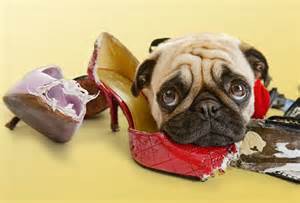
All dogs have a natural tendency to chew; you just have to learn how to control it. Chewing can become a destructive behavior if left unchecked. Some of the most common reasons for dogs chewing are:
- Puppy Teething
- Boredom
- Excess Energy
- Anxiety
- Curiosity
What you want to do here is to have your dog chew on the right things and not on your furniture or other things that you own. Do this by providing your dog with plenty of chew-able toys. When you are away, place your dog in their crate or in a confined area to prevent any wrong chewing. To correct this behavior you must be present when your dog chews on the wrong item. Correct your dog with a sharp noise and replace the item with his/her toy.
All puppies will begin to start teething at about 4 to six weeks after birth. At about three months after birth, they begin to lose their baby teeth and receive their adult teeth. This process can be up to three to five months depending upon breed of dog. Be sure that your dog, during this stage, has plenty of chew-able toys to chew on. Otherwise, you will be seeing him chewing on things that are off limits.
Back to Most Common Dog Behavior Problems topics.
Video: How To Curb Dog Chewing
Below is a video on how to curb your dog’s chewing behavior.
One of the easiest things you can do to help avoid unnecessary chewing is that they get plenty of exercise which will release some of the excess energy they have built up.
Back to Most Common Dog Behavior Problems topics.
Digging Behavior

One of the most common instincts that dogs have is digging. If this behavior is not corrected your backyard will have plenty of holes. Why do dogs dig? Here are some reasons:
- Boredom or Excess Energy
- Anxiety or Fear
- Hunting Instinct
- Comfort-Seeking (such as nesting or cooling off)
- Hiding Possessions (like bones or toys)
- To Escape or Gain Access
Back to Most Common Dog Behavior Problems topics.
Digging Video
Below is a short video on how to correct your dog’s digging behavior. Take of look! To read more information on dog digging behavior, click on the following link: dog’s digging behavior.
Back to Most Common Dog Behavior Problems topics.
Dog Digging Tips
First and foremost do not leave your dog outside to play on his/her own. If left unattended or unsupervised, they will find some activity to entertain themselves with and digging will be on top of their list. They will be digging holes all over your yard. The question is; how can I fix this problem? Here are some suggestions to help:
- Provide an area that is safe for your dog to dig in. You may bury some of his favorite toys in this area to allow him to dig to find them. If you should see your dog digging in an unwanted area, correct this behavior and take him to the safe area. Praise him and give him a treat for digging in this area.
- Do not allow any toys of his to be outside. Play only with toys that the both of you are involved with. The temptation will be for your dog to bury them.
- Be sure he/she gets plenty of exercise. Dogs need exercise daily and if they do not receive it, they will do some activities to release some of this excess energy. The results may not be what you are expecting to see.
- Take your dog to the dog park if one is in your area.
- Keep an eye on the temperature. As it gets warm during the summer months, dogs like to dig to keep cool. You will need to control and supervise his outdoor exercise activities on warm and hot days.
By doing some of the suggestions above will definitely reduce the behavior of boredom that is common with most dogs and his digging.
Back to Most Common Dog Behavior Problems topics.

Inappropriate Elimination Behavior
Dogs that display urination and defecation are among the worst of dog behaviors that owners must deal with. This behavior causes damage to areas of your home and makes your dog unwelcome in public and at the homes of friends and neighbors.
Back to Most Common Dog Behavior Problems topics.
Inappropriate Urination Behavior Video
Review the video below on possible causes of this behavior.
Back to Most Common Dog Behavior Problems topics.
Causes Of Urination Behavior
You need to determine if this behavior has to do with a health problem and it’s important to discuss this with your veterinarian so they can rule out any health issues before taking any corrective action. If there is no medical cause try to determine the reason for this behavior. Here are some possible causes:
- Submissive/Excitement Urination – Submissive dogs pee when they are greeted, when someone approaches, when they are punished, or if the dog is shy, timid and anxious. Avoid scolding your dog and try teaching some simple commands like “sit” “come” or “stay”.
- Excitement Urination – This is most likely to happen with puppies that are under one year of age. They usually grow out of it. In the meantime, don’t punish your dog or pup. Reward your puppy and praise when they pee in the correct area.
- Territorial Marking – Many dogs mark their territory by using their urine. You can train your dog to stop this practice.
- Anxiety – Requires training by the owner to stop this behavior.
- Lack of proper housebreaking – Requires training by the owner.
Urine elimination is unavoidable in puppies, especially before twelve weeks of age. However, older dogs are another question and may require some behavior modifications and training sessions to rid them of this habit.
Back to Most Common Dog Behavior Problems topics.
Jumping Behavior
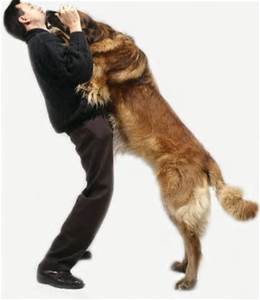
Another common behavior found in dogs is jumping. This can be annoying because you may feel like you are being attacked by an excited or exuberant dog whenever you enter the room or come in through the front door. It can be dangerous if you should have any small children in the home. Not all is lost; you can train your dog to stop jumping. Puppies jump up to reach and greet their mothers. Later, they may jump up when greeting people. Dogs may also jump up to exert dominance.
Back to Most Common Dog Behavior Problems topics.
Jump Training Video
To help you with stopping your dog to jump, check out the video below.
Stop Dog To Jump Video
Back to Most Common Dog Behavior Problems topics.
Why Dogs Jump
The main reason why dogs jump is to gain your attention. Dog owners reinforce this behavior by giving them what they are seeking even it its negative attention. Dogs do not realize you are pushing them off or yelling at them to get down is punishment. They view this as what they are seeking your attention. This is perceived as a reward. Your objective is to reward them for keeping their four paws on the floor and not on you.
Back to Most Common Dog Behavior Problems topics.
Training Your Dog Not To Jump
You now must train your dog not to jump not only on you, but all other visitors you may have that come to visit you in your home. Follow these easy steps:
- Withhold Your Attention
- Reward Good Behavior
- Practice Makes Perfect
- Add A “Sit” Command
- Practice With Other People
Back to Most Common Dog Behavior Problems topics.
Withhold Your Attention
This will probably be the most difficult step to take in withholding your attention to your dog. However, if you want him to stop jumping, follow these steps:
- As soon as your dog jumps up, turn your back on him. Cross your arms over your chest, and don’t make a sound. If the dog runs around to jump again, turn the other way so your back is against to him. Wait for him to stop jumping.
- Another method is to remove yourself altogether. If your dog jumps up when you walk in the door, turn around and walk back outside. If he jumps up when you’re inside, walk out of the room. Wait a moment, and step back inside. Repeat this until your dog is calm.
Back to Most Common Dog Behavior Problems topics.
Reward Good Behavior
In order to reward your dog when he displays the proper behavior, you will need to have some of his favorite treats available.
- When your dog is in front of you with all four paws on the ground, throw him a treat.
- Give him praise.
- Keep things low key.
Too much excitement may stimulate your dog to start jumping again. This is what you want to avoid.
Back to Most Common Dog Behavior Problems topics.
Practice Make Perfect
It will take time and patience on your part for this step. You will need to set up the situation to practice with your dog until he learns not to jump.
- If he jumps when you walk through the door or room, spend a few minutes a day coming and going.
- Do not make a fuss over the dog, just step back outside if he jumps up.
- Reward him every time all four paws are on the floor.
Back to Most Common Dog Behavior Problems topics.
Add a Sit Command
When your dog is able to keep all four paws on the floor for a few seconds or more you can begin to train him to sit.
- Walk into a room or through the front door, and give the command “sit.”
- When your dog sits, give him a treat.
- Practice this over several training sessions.
With practice and patience whenever you walk into the room or enter the front door your dog will be sitting. This is your objective.
Back to Most Common Dog Behavior Problems topics.
Practice With Other People
After your dog sits whenever you enter or go, you need to practice with other family members and your friends. Your dog must learn not to jump on anyone who comes through the front door or when entering the room. He must keep all four paws on the floor. Remember, to reward him for showing the proper behavior. By following the above, you should see a reduction of his jumping behavior.
Back to Most Common Dog Behavior Problems topics.
Separation Anxiety Behavior

Dogs experience separation anxiety whenever their owners leave the home. Being left alone causes your dog to panic. This is a behavior if left unchecked can become destructive. Dogs tend to bark, destroy things, and have housebreaking accidents whenever you leave.
When you return home, their greetings are often frantic. Separation anxiety is a stressful condition not only for the pet but also the owners and regular obedience training will not solve this behavior.
Back to Most Common Dog Behavior Problems topics.
Dog Separation Anxiety Video
If you suspect that your dog is suffering from separation anxiety, watch the video below.
Back to Most Common Dog Behavior Problems topics.
The good news is that something can be done to help reduce your dog’s anxiety. It is referred to as “systematic desensitization“, and it is a method of gradually allowing your dog to get used to being left home alone. The following will guide you through the process:
Most dog owners make the mistake of boredom for separation anxiety. Both are associated with problem behaviors like destructive chewing and excessive barking. The difference is that boredom can be overcome with more exercise and mental stimulation to your dog’s routine, and they will not have any impact on separation anxiety.
Back to Most Common Dog Behavior Problems topics.
2. Change Your Personal Behavior.
Most of us follow a routine just before we leave the house – wake up to an alarm, shower, dress, put on coat, and grab a lunch pail or work related materials. Your dog will recognize your daily routine and start building his anxiety from the time the alarm goes off. This build up will be happening before you go out the door. To prevent this building anxiety, pay attention to the things you before you leave the house, and begin to do them randomly throughout the day. For example, grab your keys and sit down to watch television, or put your coat on to feed your dog. Within a few weeks your dog should no longer see these things as signs that you are going out the door.
Back to Most Common Dog Behavior Problems topics.
3. Keep Coming and Going Low-Key.
Most owners like to give lavish affection when leaving their dogs and do the same thing when they return home. This can lead to your dog’s anxiety. Try doing this is when you leave; ignore your dog when going and for several minutes when you return home. The message you are telling your dog is that your coming and going is no big deal. For mild and moderate cases of separation anxiety, these steps may be enough to ease your dog’s anxiety behavior.
Back to Most Common Dog Behavior Problems topics.
4. Work Your Way Up to Longer Periods Away.
This step requires lots of time and a real commitment from the dog owner. It’s important that once this step is started, the dog is never to be left alone for an extended period of time until his anxiety is completely gone. This process may take several weeks to get to this point, and will need to consider taking some vacation time, hire a pet sitter, or find a dog daycare until this process is completed. Use this step if only steps 1 through 3 do not work. Develop a plan and then execute it and make sure your dog is never alone, as it is time for your dog to get used to your being away. Plan on thirty minute training sessions to start.
- Start by stepping out the door for a short amount of time, and step right back inside. Be careful not to step outside long enough for your dog’s anxiety to begin building, in severe cases this may be only for one second. When you step back inside, keep things quiet, and give him a few minutes to relax. Once he is relaxed, step back outside again, and repeat this step until your dog is not showing any signs of anxiety – no panting, pacing, or drooling.
- Next, now slowly begin to increase the amount of time you are gone. Again, this might only moving up to two seconds, then three, and so on for severe cases of anxiety. Once you start to add time, you can mix up the lengths of time you step out during a training session. For example, if you are able to step outside for five minutes, step out for five minutes and then three minutes. Change it up, but do not go beyond the five minutes until your dog is showing no signs of anxiety.
- Once you have worked adding time you are gone for about 45 minutes, you should be able to begin adding time more quickly. You can work up to leaving your dog alone for an hour, two hours and then for an entire work day.
- If you are able to devote an hour or more to your dog’s training sessions you should begin to see some results in your dog’s improvement within a few weeks. If you have followed the steps and your dog is still showing signs of anxiety, you may need to seek help. Contact your veterinarian and they can help you decide if medication or a behaviorist is the next step for your dog.
Back to Most Common Dog Behavior Problems topics.
Separation Anxiety Behaviors
To determine if your dog has separation anxieties observe if your dog does any of the following:
- The dog follows you around the house and is upset as you are preparing to leave
- Your dog acts anxious or distressed when alone
- Often become extremely vocal when you are away
- Destroys property when you are away
- Displays excess chewing behavior such as on some of your personal items
- Forgets his potty training
- Becomes anxious when you prepare to leave
- Misbehavior occurs in the first 15-45 minutes after owner leaves
- Dog tries to be touching owner whenever possible
If you should observe any of the above signs it is possible that your dog is suffering from separation anxiety and this behavior should be dealt with as quickly as possible.
Back to Most Common Dog Behavior Problems topics.
Conclusion
Now that you know the most common behaviors that dogs exhibit you can begin to take corrective action whenever they display any of them. You also know the cause how your pet displays these behaviors. As the owner, your pet is looking to you to make the correct decision. Otherwise, you will find your self seeing what your dog will do when he/she takes the leadership role.
Back to Most Common Dog Behavior Problems topics.
Purchase Dog Training Behavioral Helps
If you just purchased or brought home your new puppy or dog, below are some behavioral helps that you can use in your training sessions.
As an Amazon associate, I earn from qualified purchases.
ROW 1
ROW 2
ROW 3
Back to Most Common Dog Behavior Problems topics.
Back to Dog Luxury Beds home page.
